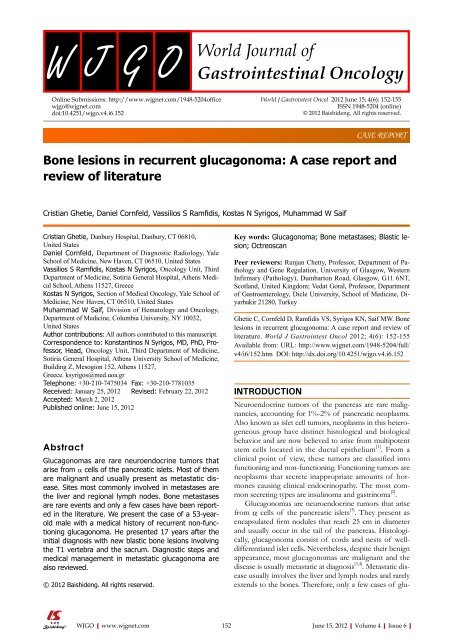6 - World Journal of Gastroenterology
6 - World Journal of Gastroenterology
6 - World Journal of Gastroenterology
You also want an ePaper? Increase the reach of your titles
YUMPU automatically turns print PDFs into web optimized ePapers that Google loves.
Online Submissions: http://www.wjgnet.com/1948-5204<strong>of</strong>fice<br />
wjgo@wjgnet.com<br />
doi:10.4251/wjgo.v4.i6.152<br />
Bone lesions in recurrent glucagonoma: A case report and<br />
review <strong>of</strong> literature<br />
Cristian Ghetie, Daniel Cornfeld, Vassilios S Ramfidis, Kostas N Syrigos, Muhammad W Saif<br />
Cristian Ghetie, Danbury Hospital, Danbury, CT 06810,<br />
United States<br />
Daniel Cornfeld, Department <strong>of</strong> Diagnostic Radiology, Yale<br />
School <strong>of</strong> Medicine, New Haven, CT 06510, United States<br />
Vassilios S Ramfidis, Kostas N Syrigos, Oncology Unit, Third<br />
Department <strong>of</strong> Medicine, Sotiria General Hospital, Athens Medical<br />
School, Athens 11527, Greece<br />
Kostas N Syrigos, Section <strong>of</strong> Medical Oncology, Yale School <strong>of</strong><br />
Medicine, New Haven, CT 06510, United States<br />
Muhammad W Saif, Division <strong>of</strong> Hematology and Oncology,<br />
Department <strong>of</strong> Medicine, Columbia University, NY 10032,<br />
United States<br />
Author contributions: All authors contributed to this manuscript.<br />
Correspondence to: Konstantinos N Syrigos, MD, PhD, Pr<strong>of</strong>essor,<br />
Head, Oncology Unit, Third Department <strong>of</strong> Medicine,<br />
Sotiria General Hospital, Athens University School <strong>of</strong> Medicine,<br />
Building Z, Mesogion 152, Athens 11527,<br />
Greece. ksyrigos@med.uoa.gr<br />
Telephone: +30-210-7475034 Fax: +30-210-7781035<br />
Received: January 25, 2012 Revised: February 22, 2012<br />
Accepted: March 2, 2012<br />
Published online: June 15, 2012<br />
Abstract<br />
Glucagonomas are rare neuroendocrine tumors that<br />
arise from α cells <strong>of</strong> the pancreatic islets. Most <strong>of</strong> them<br />
are malignant and usually present as metastatic disease.<br />
Sites most commonly involved in metastases are<br />
the liver and regional lymph nodes. Bone metastases<br />
are rare events and only a few cases have been reported<br />
in the literature. We present the case <strong>of</strong> a 53-yearold<br />
male with a medical history <strong>of</strong> recurrent non-functioning<br />
glucagonoma. He presented 17 years after the<br />
initial diagnosis with new blastic bone lesions involving<br />
the T1 vertebra and the sacrum. Diagnostic steps and<br />
medical management in metastatic glucagonoma are<br />
also reviewed.<br />
© 2012 Baishideng. All rights reserved.<br />
<strong>World</strong> J Gastrointest Oncol 2012 June 15; 4(6): 152-155<br />
ISSN 1948-5204 (online)<br />
© 2012 Baishideng. All rights reserved.<br />
Key words: Glucagonoma; Bone metastases; Blastic lesion;<br />
Octreoscan<br />
Peer reviewers: Runjan Chetty, Pr<strong>of</strong>essor, Department <strong>of</strong> Pathology<br />
and Gene Regulation, University <strong>of</strong> Glasgow, Western<br />
Infirmary (Pathology), Dumbarton Road, Glasgow, G11 6NT,<br />
Scotland, United Kingdom; Vedat Goral, Pr<strong>of</strong>essor, Department<br />
<strong>of</strong> <strong>Gastroenterology</strong>, Dicle University, School <strong>of</strong> Medicine, Diyarbakir<br />
21280, Turkey<br />
Ghetie C, Cornfeld D, Ramfidis VS, Syrigos KN, Saif MW. Bone<br />
lesions in recurrent glucagonoma: A case report and review <strong>of</strong><br />
literature. <strong>World</strong> J Gastrointest Oncol 2012; 4(6): 152-155<br />
Available from: URL: http://www.wjgnet.com/1948-5204/full/<br />
v4/i6/152.htm DOI: http://dx.doi.org/10.4251/wjgo.v4.i6.152<br />
INTRODUCTION<br />
CASE REPORT<br />
Neuroendocrine tumors <strong>of</strong> the pancreas are rare malignancies,<br />
accounting for 1%-2% <strong>of</strong> pancreatic neoplasms.<br />
Also known as islet cell tumors, neoplasms in this heterogeneous<br />
group have distinct histological and biological<br />
behavior and are now believed to arise from multipotent<br />
stem cells located in the ductal epithelium [1] . From a<br />
clinical point <strong>of</strong> view, these tumors are classified into<br />
functioning and non-functioning. Functioning tumors are<br />
neoplasms that secrete inappropriate amounts <strong>of</strong> hormones<br />
causing clinical endocrinopathy. The most common<br />
secreting types are insulinoma and gastrinoma [2] .<br />
Glucagonomas are neuroendocrine tumors that arise<br />
from α cells <strong>of</strong> the pancreatic islets [3] . They present as<br />
encapsulated firm nodules that reach 25 cm in diameter<br />
and usually occur in the tail <strong>of</strong> the pancreas. Histologically,<br />
glucagonoma consist <strong>of</strong> cords and nests <strong>of</strong> welldifferentiated<br />
islet cells. Nevertheless, despite their benign<br />
appearance, most glucagonomas are malignant and the<br />
disease is usually metastatic at diagnosis [3,4] . Metastatic disease<br />
usually involves the liver and lymph nodes and rarely<br />
extends to the bones. Therefore, only a few cases <strong>of</strong> glu-<br />
WJGO|www.wjgnet.com 152<br />
June 15, 2012|Volume 4|Issue 6|

















